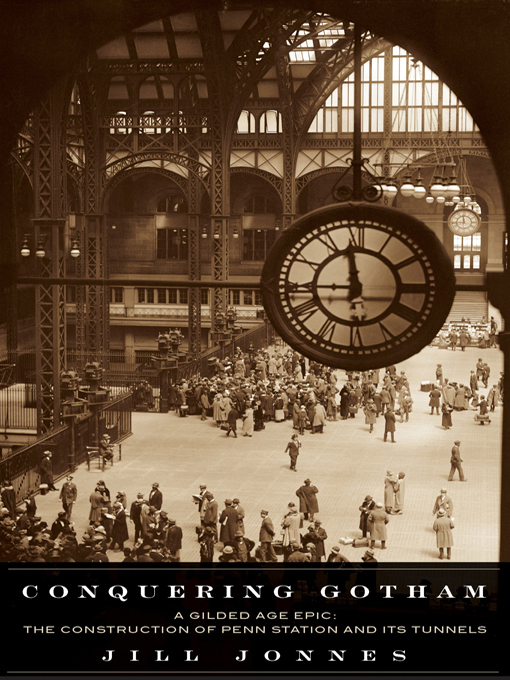As bestselling books like Ron Chernow's Titan and David McCullough's The Great Bridge affirm, readers are fascinated with the grand personalities and schemes that populated New York at the close of the nineteenth century. Conquering Gotham re- creates the riveting struggle waged by the great Pennsylvania Railroad to build Penn Station and the monumental system of tunnels that would connect water-bound Manhattan to the rest of the continent by rail. Historian Jill Jonnes tells a ravishing tale of snarling plutocrats, engineering feats, and backroom politicking packed with the most colorful figures of Gilded Age New York.
Conquering Gotham will be featured in an upcoming episdoe of PBS's American Experience.
-
Creators
-
Publisher
-
Release date
April 19, 2007 -
Formats
-
Kindle Book
-
OverDrive Read
- ISBN: 9781101218891
-
EPUB ebook
- ISBN: 9781101218891
- File size: 1700 KB
-
-
Languages
- English
-
Reviews
-
Publisher's Weekly
February 19, 2007
Modern Manhattan is a miracle in many ways, but all of its imports, commuters included, must traverse at least one river to get there. In 1900, the New York Central, owned by the Vanderbilts, already gave Manhattan a northern connection over the narrow Harlem River. A southern connection over the mile-wide Hudson would be a whole different story. Alexander Cassatt, president of the Pennsylvania Railroad, was the visionary on the project. But how to do it? A bridge plan fell through due to expense; a tunnel would lack the oxygen needed for steam engines. The breakthrough lay in the cutting-edge electrified locomotives developed in Paris. Historian Jonnes (Empires of Light
), demonstrating impressive immersion in the Gilded Age, ably spins the tale, which bears some similarities to The Devil in the White City
. This is a vivid story of hardball Tammany Hall maneuvering and mind-boggling engineering. Once construction began, the two-track narrative settles on the daunting construction of the tunnels and Charles McKim's much-admired design of the terminus at Pennsylvania Station, prized by New Yorkers only after its ill-considered demise in 1963. Jonnes can claim an important addition to the popular literature of how New York became the archetype of a great American metropolis. -
Library Journal
Starred review from February 15, 2007
In 1901, the Pennsylvania Railroad (PRR) embarked on an epic nine-year project to bring its tracks into New York City. It would involve two tunnels under the Hudson River, four under the East River, and the building of the majestic Penn Station in midtown Manhattan. In her meticulous history, Jonnes ("Empires of Light: Edison, Tesla, Westinghouse, and the Race To Electrify the World") brings to life the project's leaders, its workers, and early 1900s New York City. She carefully explains how engineering decisions were made to overcome the extremely difficult tunneling conditions. She creates suspense over the PRR's investigation of why the Hudson River tunnels kept shifting in the riverbed's silt. She gives full attention to the McKim, Mead & White architectural designs for Penn Station and details the sensational Stanford White murder and trial. Throughout, she seamlessly weaves in the machinations of the Tammany Hall political machine and the imperious practices of Gilded Age business tycoons. In a sad epilog, she chronicles the decline of the PRR and Penn Station's demolition in 1963. Several dozen superbly chosen period photos and diagrams round out the book. Jonnes has produced a well-researched and fast-paced history that is most highly recommended to all libraries.Lawrence R. Maxted, Gannon Univ., Erie, PACopyright 2007 Library Journal, LLC Used with permission.
-
Booklist
March 1, 2007
Commemorated in many a rueful history book after "barbarians" demolished it in the 1960s, New York City's Pennsylvania Station was the visible manifestation of a titanic subterranean project. Its sweeping story, involving engineering challenges, an inflexibly honest corporation leader, flexibly corrupt politicians, and street-level sociology, comes together marvelously in Jonnes' admiring history of the undertaking. It arose from the Pennsylvania Railroad's determination to run its trains directly into Manhattan; in the 1890s, Penn passengers had to alight in New Jersey and board ferries, a scene Jonnes evokes with an excerpt of Penn president Alexander Cassatt's experience of the inconvenience. The main impetus to the enterprise, Cassatt, operating in an era of lightly regulated capitalism, wielded substantial power, and his decisions structure Jonnes' narrative. Cassatt's siting of the station in the city's notorious den of iniquity, the Tenderloin, introduces the outstretched palms of Tammany Hall, while his taste for the classical aesthetic introduces Charles McKim's design of the station. Equally interesting on the technical hazards of the tunnel work, Jonnes has produced an exemplary construction epic.(Reprinted with permission of Booklist, copyright 2007, American Library Association.)
-
Formats
- Kindle Book
- OverDrive Read
- EPUB ebook
subjects
Languages
- English
Loading
Why is availability limited?
×Availability can change throughout the month based on the library's budget. You can still place a hold on the title, and your hold will be automatically filled as soon as the title is available again.
The Kindle Book format for this title is not supported on:
×Read-along ebook
×The OverDrive Read format of this ebook has professional narration that plays while you read in your browser. Learn more here.



